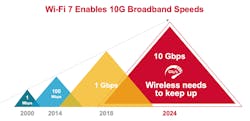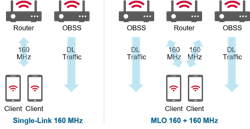Wi-Fi 7: Wi-Fi Reimagined for the Connected World
What you’ll learn:
- New features you’ll find in Wi-Fi 7.
- What benefits will those features bring?
- When will Wi-Fi 7 become available?
As Wi-Fi nears its 25th anniversary, the technology is so widespread that it’s effectively become a utility for many people. While Wi-Fi speeds have increased at a rate that mirrors Moore’s Law, the underlying technology was largely the same for the first 20 years of its life. It wasn’t until Wi-Fi 6 was launched in late 2018 that Wi-Fi operations could, for the first time, be scheduled, which led to a major increase in Wi-Fi efficiency.
Key Wi-Fi applications have embodied both the growth in speeds and the innovations that started with Wi-Fi 6. Fifteen years ago, 802.11n (a.k.a. Wi-Fi 4) was a great mechanism for delivery of connectivity to a handful of devices in a home or office. When 802.11ac (Wi-Fi 5) was introduced, its higher speeds quickly made it the primary delivery mechanism for mobile video and over-the-top streaming.
In turn, Wi-Fi 6 and 6E used scheduling to vastly improve the performance of real-time video conferencing and mobile uploading, and quickly became the dominant technology in the market. Since 2019, Broadcom has shipped more than 1 billion Wi-Fi 6/6E devices.1
Going forward, several usage trends are driving the next generation of Wi-Fi. With the increase in remote work and virtual provision of services, 2021 saw major increases in spending on mobile gaming and virtual-reality products, leading to increased focus on reducing latency in these applications.
In parallel, operators worldwide are preparing for the introduction of 10-Gb/s cable-modem and fiber-optic broadband connections to homes and businesses. In addition, the 6-GHz band is now available for Wi-Fi usage in nearly 50 countries, with more than 75 additional countries contemplating opening the 6-GHz band.
This is where Wi-Fi 7 comes in: Combining 6-GHz spectrum, scheduling enhancements, and high-speed broadband (Fig. 1), it provides the wireless backbone for whole home multi-gigabit service. Wi-Fi 7 also delivers high reliability for key future services like virtual and augmented reality (VR/AR) and next-generation mobile gaming.
What’s New in Wi-Fi 7?
Wi-Fi 7 has several major new features (Fig. 2). For the all-important “number on the box,” it introduces 320-MHz-wide channels, double the bandwidth supported by Wi-Fi 6/6E, and 4096-QAM modulation. Together, these features deliver 2.5X higher top-line throughput for all devices.
Wi-Fi 7 also introduces Multi-Link Operation (MLO), which, like cellular carrier aggregation, allows a device to connect to two independent channels simultaneously and route data in real-time (with switching times on the order of a few tens of microseconds) to whichever channel is optimal for latency and throughput. This is a critical new feature because quality of service and latency have become important metrics for wireless devices.
While higher top speeds improve those metrics by increasing available airtime, prior generations of Wi-Fi could see significantly degraded latency, particularly in congested environments.
MLO greatly improves both latency and throughput even in simple scenarios. For example, take the case of a Wi-Fi 6 access point, which allows a device to connect on a single 160-MHz channel, and a Wi-Fi 7 access point that supports MLO on two 160-MHz channels simultaneously (Fig. 3).
With no other traffic on the channel, both configurations achieve the same performance. But interference from an overlapping access point (referred to as OBSS) causes the single link’s performance to degrade. It occurs because the OBSS attempts to transmit at the same time as the main access point. This blocks the single-link Wi-Fi 6 device from transmitting and receiving data, which degrades both its throughput and latency.
The Wi-Fi 7 MLO client device, on the other hand, monitors two channels simultaneously. Even though the OBSS interference increases the likelihood that each of the two channels are unavailable, the client has two opportunities in real-time to find an open channel. The Wi-Fi 7 client sees a throughput boost of up to 50% depending on the OBSS loading, and a 60% reduction in 99th-percentile latency, which is critical for virtual reality and gaming.2
To protect incumbent operations in the 6-GHz band, Wi-Fi 6E was constrained to operate indoors and at low power. which limits the performance of Wi-Fi 6E as well as the applications that it can serve. The good news is that Wi-Fi 7 can overcome these limitations using Automated Frequency Coordination (AFC), which permits devices to operate outdoors and at higher power levels based on geolocation.
It can be difficult to extract gains from shared spectrum, but the AFC process for 6 GHz is relatively lightweight (Fig. 4). To use the AFC service, an access point must know its location, and look up allowable channels and power levels in a cloud-based database.
Those channels and power levels are determined by interference calculations that avoid potential interference with other users of the 6-GHz band. Approval to use a channel is valid for a 24-hour period, resulting in a very simple process to achieve significantly longer range and access more spectrum than is possible today.
Putting it All Together
Altogether, these features deliver a significant improvement in user experience. Wi-Fi 7 can deliver 5 Gb/s to smartphones, compared to 2 Gb/s today. Wi-Fi 7 also brings major improvements to congested network performance (Fig. 5): a 5X boost in capacity, 100X reduction in latency, 15X improvement in determinism, and a 63X range increase.3
With increased speed and range, and major improvements in latency and determinism, Wi-Fi 7 will deliver wireless services for the next decade, whether for gaming and critical low-latency technologies like AR and VR, or for improved user experience in venues, offices, educational institutions, and telemedicine.
Wi-Fi 7 also brings major improvements to home Wi-Fi experience, with improved mesh networking, multi-gigabit whole-home throughput, optimal video streaming and AR/VR performance, multi-link redundancy, and significantly increased range.
Wi-Fi 7 is Here
Earlier this year, Broadcom was the first to announce a full ecosystem of Wi-Fi access point and client devices, and the company is working with several other suppliers to make sure everyone’s devices are interoperable. Its customers are already designing new products with device samples, and pre-certified Wi-Fi 7 devices are expected to be in mass production by mid-2023, with full certification expected by mid-2024.
References
1. Wi-Fi 7 Info: https://www.broadcom.com/info/wifi
2. Broadband Wi-Fi AP Solutions: https://www.broadcom.com/solutions/broadband-wired-networking/broadband-wi-fi-ap-solutions
3. WFA: https://www.wi-fi.org/who-we-are/current-work-areas#Wi-Fi%207
About the Author
Gabriel Desjardins
Director of Product Marketing, Wireless Communications and Connectivity Division, Broadcom
Gabriel Desjardins is a director of product marketing for the Wireless Communications and Connectivity division at Broadcom. He focuses on product management and marketing for mobile connectivity devices, including Wi-Fi 6, 6E, 7, and Bluetooth product lines. He began his career as an RF circuit designer and worked as a data scientist prior to joining Broadcom. He has an MSEE from UC Berkeley, and a Bachelor’s degree from Queen’s University in Canada.





